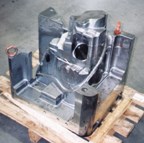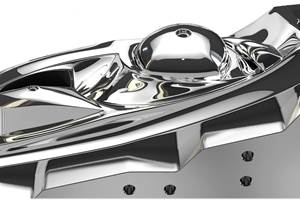Sub-harmonic Stress Relief Improves Mold Quality
The quality of the mold lies mostly beneath the surface of the steel. By using sub-harmonic stress relief, moldmakers can improve mold quality - enhancing machine stability, long-term shape stabilization and the mold's resistance to cracking in service.
Mold quality can be affected by several factors - chemical composition, heat treatment, speeds and feeds of cuts, sharpness of cutters, etc. Perhaps the most significant factor that affects the consistency of mold performance is residual stress.
Residual stress is an internal pressure that is retained following mechanical or thermal straining.(1) Mechanical stress is caused by forcibly changing the shape of the grains - such as cold rolling, bending and stamping. Thermal stress is caused by a sharp temperature drop on a metal part such as welding, casting, hot rolling, machining, grinding, EDM'ing and hardening. The sharper the temperature drop, the more intense the pressure will be. Thermal stress leads to three types of problems:
- Distortion immediately following machining or grinding.
- Delayed distortion.
- Premature cracking.
Mechanical stress can easily be calculated. Accurate distortion and fatigue limits from mechanically stressed components can be accommodated for in the component's design to set and predict reasonable operating capacity. But this is not so with thermally stressed components. Thermal stress is extremely difficult to calculate and is not widely understood by most engineers.
Thermal stress can vary in strength from a negligible amount to an amount that is in excess of the material's yield strength. Therefore, reducing thermal stress becomes the key to achieving and maintaining consistently high quality in molds.
Dealing With Thermal Stress
There are three ways to deal with thermal stress. The first way is to ignore it and suffer the consequences. These consequences include such things as allowing more stock to remove, taking more cuts across surfaces, a higher scrap rate, more frequent and extensive repairs and early replacement of the mold. This approach is risky since it could lead to more machining time, extra costs, wasted raw materials and dissatisfied customers.
The second method is to minimize any thermal shock on the mold block, if possible. Examine every manufacturing step along the way. Wherever a sharp temperature drop occurs insist on a slower cooling rate - unless the cooling rate is necessary for mechanical properties enhancement. For example, if a billet of mold steel is set on the ground to cool off, request that it be separated from the ground even slightly. Or better yet, have it wrapped in an insulated blanket during cooldown.
The third way to deal with thermal stress is to stress relieve the mold block by using one of several different methods. Thermal stress can be reduced using either thermal or mechanical means.(2) In the past, the common method of stress relief has been by using heat. But heat treat stress relief, although effective, has many drawbacks including time, expense, treatment distortion, surface oxidation, changing mechanical properties and limitations on size and weight. Other stress relief methods have not been widely used for obvious reasons. Natural aging takes too long. Cryogenics is too expensive and limited in size. Stretch and compression require simple shaped parts. And finally, vibration, which - although it has none of these limitations - has witnessed industry's reception varying between being very receptive and being very skeptical and resistant.
However, just as heat has many different energy levels to accomplish certain goals, vibrational energy can be varied with a dramatic impact on the effectiveness and consistency of the process.
The Sub-harmonic Alternative
The potential benefits of timesavings, cost savings and quality improvement that vibration stress relief could provide to the moldmaking industry are enormous - but only if the process is successful on a consistent basis (see Figures 1 and 2). One vibration stress relief process that has experienced consistently successful results in the metalworking industry uses what is called sub-harmonic technology.
Sub-harmonic vibration technology was developed to deal with inconsistent results when using the former resonant vibration approach. The developers of this process required parts treated by vibration to meet or exceed the performance of parts that were heat treat stress relieved. In discovering the key principles behind using vibrational energy to generate successful stress relief results, the former theories of using vibrations had to be discarded and an advanced procedure developed.
The sub-harmonic vibration stress relief process has two fundamental principles:
- Sub-harmonic energy must be used for the stress relief dwell frequency; and
- The harmonic curve of a thermally stressed metal part will shift and stabilize to a new frequency location as the workpiece becomes relieved of thermal stress.
Principle 1 - Sub-harmonic Energy
Metal components exhibit a harmonic reaction to induced energy. The harmonic curve occurs when the vibrated component cannot dissipate any more energy from the force inducers and responds with an out-of-proportion amplitude movement. At and near the leading edge of the harmonic curve (i.e., sub-harmonic zone) is the optimum frequency for using vibrational energy for stress relief. The significance of finding the harmonic curve clearly establishes where the sub-harmonic zone is. The sub-harmonic zone is defined as the leading lowest 1/3 portion of the harmonic curve for low strength metals and 1/3 to 1/2 portions for high-strength and exotic metals.
In 1987, Richard Skinner, a professional engineer at Lockheed Missiles and Aerospace, mathematically proved that when using vibrations to achieve stress relief, a slightly lower frequency than the harmonic peak frequency must be used.(3) Skinner verified this theory on eight different metals.
Note: Former vibration methods operated at the highest amplitude peak (resonance) that the workpiece experienced. This resonant approach leads to inconsistent results(4) and if maintained for an extended period of time, could damage the workpiece.(5)
Following a scan of the mold block, the stress relief dwell frequency of vibration is set at the appropriate sub-harmonic level and maintained at this level for 15 to 60 minutes, depending on the metal and weight of the workpiece.
Principle 2 - Shifting and Stabilizing
All metal components have a natural harmonic peak. If the part had been subjected to a thermal shock (causing thermal stress) during manufacturing, the harmonic peak would be in an unnatural frequency location. As the workpiece becomes stress relieved by applying sub-harmonic vibrations, the harmonic peak will shift and eventually stabilize in a new frequency location. The stabilized frequency would be the natural harmonic frequency.
An analogy would be like having a musical instrument out of tune (thermally stressed). As it comes into tune (stress relieved), the true natural note is heard.
Professors T.E. Wong and G.C. Johnson of the University of California, Berkeley issued a report in 1987 in which they mathematically demonstrated that "the harmonic curve will shift due to residual stress," and that "this shifting can be used to verify the relief of stresses."(6)
Beyond the initial treatment of the mold block following the first scan, the workpiece should be monitored periodically - every five to 15 minutes - and the sub-harmonic frequency readjusted every time the harmonic curve shifts. Once the harmonic curve stabilizes in a new frequency location, then stress relief is complete.
Similarities Between Sub-harmonic and Heat Stress Relief
The correct procedure must be followed to find and maintain the optimum zone for stress relief to achieve successful results for both processes. Operating outside the optimum guidelines may result in achieving no stress relief benefits or - in a worst-case scenario - it could even damage the part. Other similarities include:
- Both processes rely on internal accelerated motion to accomplish stress relief. In fact, all stress-relieving processes rely on this. Internal accelerated motion seems to be the only common denominator between all stress-relieving processes.
- Both processes require a dwell period.
- Both processes achieve stress relief benefits consistently.
- Both processes have been originally verified by industry as successful through field performance comparisons.
- Both processes have been tested and are considered as "comparable" according to a U.S. Department of Energy sponsored test.
Differences Between Sub-harmonic and Heat Stress Relief
There are several differences between sub-harmonic and heat stress relief, such as:
- Expense. The expense of sub-harmonic processing typically ranges between five to 15 percent of the costs associated with heat treat stress relieving.
- Time. The time that it takes for sub-harmonic processing is typically less than five percent of what the heat treat stress relief would require (30 to 60 minutes for sub-harmonic stress relief vs. three to five days for off-site heat treat services).
- Side effects. Sub-harmonic processing does not produce heat treat side effects such as treatment distortion, surface oxidation or scaling - or changing mechanical properties including hardness and softness. Note: If any of these heat treat side effects are desired from the stress relief process, then heat must be used.
- Secondary steps. Sub-harmonic processing eliminates the need for many secondary steps associated with heat treat stress relieving such as trucking, handling, cleaning, re-machining, inspections and rescheduling.
- Quality assurance and convenience. Sub-harmonic processing can be used virtually any time between other manufacturing steps. This allows stress relief to be applied on near-net finished, semi-finished, finished and even assembled molds and dies for quality improvement and assurance (see Figure 3).
- Certification capability. Due to the certification capability of the process, sub-harmonic processing can be used for thermal stress relief assurance. For example, checking incoming molds to verify stress relief had previously taken place.
When to Use Sub-harmonic Vibrations
It is recommended to use sub-harmonic vibrations in advance of any manufacturing step where distortion and/or cracking is likely to cause rework or scrap.
Incoming Mold or Die Block
Most mold blocks are already stress relieved as received from the steel supplier. This is done either by slow cooling or by stress relieving the mold block once it has been sawed from the billet. Because of this, most mold manufacturers do not apply any additional stress relief at this time. However, if severe distortion is expected, then sub-harmonic stress relief should be added before rough milling.
Between Rough and Finish Milling
This is the usual time for applying sub-harmonic vibrations by moldmakers. For most mold blocks, stress relieving at this time is sufficient to achieve the necessary distortion control and maintain quality throughout the service life of the mold.
Between Semi-Finish and Finish Milling
Frequently, the semi-finish milling step can be eliminated if the semi-finish pass was necessary to accommodate for the distortion that would have occurred from heat treat stress relieving. By taking advantage of the fact that there is no treatment distortion from the sub-harmonic stress relief process, a closer net finish can be milled from roughing. However, if very close tolerances are desired and a semi-finish pass is necessary, then adding a sub-harmonic treatment at this time will greatly reduce the distortion of the finish pass and polishing.
Before Rough EDM - Wire or Sinker
Dies that require EDM machining have typically been ground after stress relieving. Even marginal thermal stress in these die blocks could cause distortion or cracking of the block or pinching of the wire. To apply sub-harmonic stress relief at this time would minimize - if not eliminate - these problems (see Figure 4).
Before Shipping to a Customer
With a finished mold or die, apply sub-harmonic stress relief for quality assurance for the customer.
During Welding
For repairing and rebuilding of molds, apply sub-harmonic vibrations during welding (weld conditioning). This generally produces a finer weld grain structure and allows the welder to use fewer amps (see Figures 5 and 6). Ultimately, sub-harmonic weld conditioning results in less distortion from welding and less susceptibility to cracking (see Figure 7).
Summary
Stress relief is important to molds and dies to assure consistent quality of performance as evidenced by machine distortion control, long-term shape stabilization and reducing premature cracking in service. The sub-harmonic vibration process has been verified academically as well as proven in field applications as an effective stress relief alternative to other methods including the heat treat stress relief process. This process is an advancement over former vibration stress relief techniques. In addition, the sub-harmonic process can be used during welding to reduce distortion from welding and cracking.
REFERENCES
1. Van Vlack, Lawrence. Elements of Materials Science, 2nd Edition, Addison-Wesley, 1967, p. 407.
2. Connor, Leonard P. Welding Handbook, Welding Technology, 8th Edition, AWS, 1989, p. 219.
3. Skinner, Richard P.E. An Investigation into the Theory Behind Sub-Resonant Stress Relief, 1987, p. 10.
4. SEMA, Meta-Lax Stress Relief Process, Tech Brief - DE - AC0191CE10566, U.S. Dept. of Energy, March 1995.
5. Saunders, G. Methods of Stress Relief and Their Efficacy, Residual Stresses and Their Effect, The Welding Institute, 1981, p. 42.
6. Wong, T. E. and G.C. Johnson, Ultrasonic Evaluation of the Nonlinearity of Metals from a Design Perspective, 1987, p. 15.
Related Content
Moldmakers Deserve a Total Production Solution
Stability, spindle speed and software are essential consideration for your moldmaking machine tool.
Read MoreProject Reveals Added Benefits of New P20 Grade Steel in Machinability, Cycle Time and No Stress Relief
MoldMaking Technology's Christina Fuges talks with General Motors' Shane Appel about a project testing a new P20 steel grade's dimensional stability.
Read MoreVIDEO: AM Powder Addresses Current Inefficiencies, Sustainability and Skills Gap
Steel supplier discusses high thermal conductivity metal powders that also address the skills gaps via user-friendly materials and promote sustainability via durability and higher cycle counts.
Read MoreHow to Achieve the Best Mold Finish
A look at factors that impact the polishability of tool steels and recommendations for obtaining a high-gloss finish.
Read MoreRead Next
How to Use Continuing Education to Remain Competitive in Moldmaking
Continued training helps moldmakers make tooling decisions and properly use the latest cutting tool to efficiently machine high-quality molds.
Read MoreHow to Use Strategic Planning Tools, Data to Manage the Human Side of Business
Q&A with Marion Wells, MMT EAB member and founder of Human Asset Management.
Read MoreAre You a Moldmaker Considering 3D Printing? Consider the 3D Printing Workshop at NPE2024
Presentations will cover 3D printing for mold tooling, material innovation, product development, bridge production and full-scale, high-volume additive manufacturing.
Read More




























